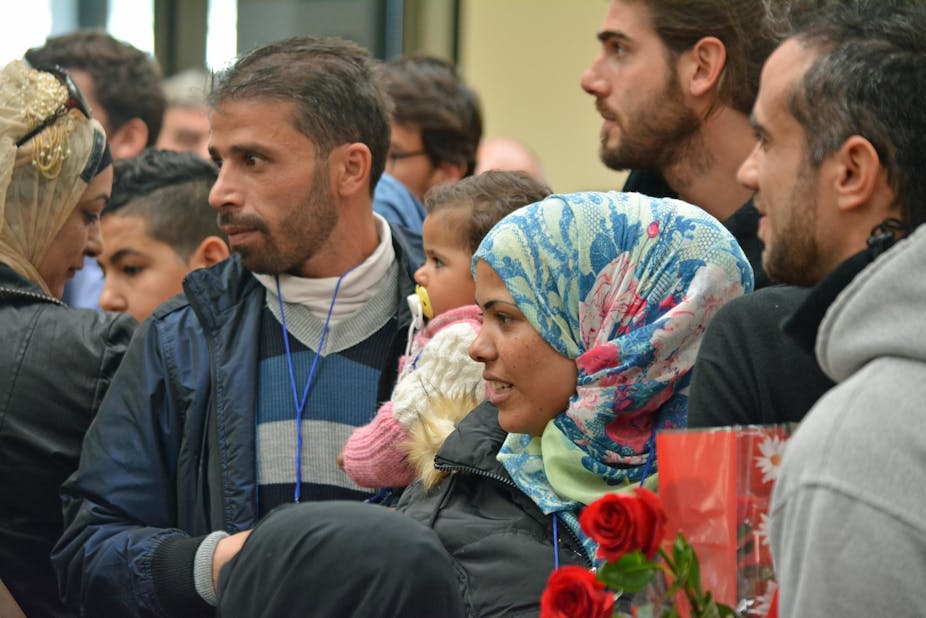Three years after a shipwreck off the island of Lampedusa killed more than 360 people, a programme is underway in Italy that seeks to save lives by providing an air route to Europe.
In contrast to moves in some European countries, the Corridoi Umanitari (humanitarian corridors) project strives to put a more humane approach into action. It does so by providing flights to people in vulnerable situations from the Middle East and North Africa to Europe.
These humanitarian corridors are the result of an ecumenical collaboration between Catholics and Protestants, including the Community of Sant Egidio, the Federation of Protestant Churches in Italy (FCEI), and the Waldensian and Methodist churches.
As a pilot project, which began earlier this year, the programme is the first of its kind in Europe. It aims to prevent border deaths at sea by providing safe flights to Italy, and also to combat smuggling and trafficking networks. In so doing, the project seeks to allow people in so called “vulnerable conditions” to enter Italy legally on the Article 25 Schengen Limited Territorial Validity (LTV) visa in order that they arrive in safety to Europe to lodge their claim for asylum or protection.

People are chosen to participate in the initiative through visits made directly by programme organisers to camps in Lebanon. During these visits, interviews are held with potential beneficiaries to assess whether their situation meets one or more of five vulnerability criteria, ranging from experiences of conflict to serious health issues. The final list is then forwarded to the Italian embassy for approval, prior to people being taken to different regions across Italy.
Since February, around 300 people have entered Italy from Lebanon via this route. Another 100 are due to arrive on October 20. So far all the beneficiaries have arrived from Lebanon. Plans to extend the project to Morocco and Ethiopia are already underway, as are efforts to introduce the initiative to European states beyond Italy such as France and Switzerland.
The Italian government has agreed to support a total of 1,000 arrivals via this mechanism over two years, though indications suggest it will be extended further. The travel and reception costs for the initiative is funded by charitable donations so it does not cost the Italian government anything.
Beyond the refugee crisis
There are some encouraging signs that these humanitarian corridors can provide a way forward from the so-called refugee crisis. First, the initiative broadens the understanding of who counts as a person in a vulnerable situation. It does not rely on questionable distinctions between political or economic migrants, or between those who have been forced and those who choose to come to the Europe, because the vulnerability criteria used do not assume such clear-cut divisions.
Second, the initiative deepens the protection of vulnerable people by providing a safe and legal route for those seeking safety in Europe, and by initiating support and integration measures immediately on arrival which are also funded by the programme. This is critical so that the rights refugees have to international protection are not diluted through a failure to provide adequate information and services.
The importance of this was highlighted by one man I spoke with in Lampedusa from Syria, who arrived in Turin, Italy via this programme with his wife in June 2016. Comparing his journey with that of his brother who travelled via the Balkan route to Europe from Turkey last year, he explains how his brother was surprised that when the couple first arrived in Turin they had a house, a flat key, and freedom to come and go. His brother spent four months instead in a camp-like a prison when he first came to Europe. “He was not dealt with as a human being,” my Syrian friend told me.
Who will step up?
Nevertheless, questions remain as to the scope of this project and to the limitations of an initiative that is not enshrined in international law and so is not a legal duty on the part of European states. There are also potential problems in its linkage to formal procedures of applying for asylum or other forms of protection in Italy, and in the ongoing existence of visa policies that seek to prevent the travel of the most vulnerable. It’s also debatable whether civil society organisations should be taking responsibility for the provision of safe routes and initial reception measures for refugees, instead of the state.
So while this pilot project is as an innovative approach to the so-called refugee crisis, it needs further development if the safe and legal routes it opens up are not to be reduced to political gesture. As Paolo Naso, a political scientist at the Università di Roma who is responsible for the programme, highlighted at a press conference about it in Lampedusa on October 3:
Is it only by chance that the only real experiment [in safe and legal routes] comes from two small independent churches and not from authorities or big institutions?
Yet the significance of providing these humanitarian corridors was readily evident as I strolled through the cemetery in Lampedusa three years after the boat disaster. Each year commemoration events are organised by the group Comitato Tre Ottobre, involving survivors of the shipwreck, family members of the deceased, non-governmental organisations and the local community. While the event brings the survivors to the fore, it is always haunted by those who are not there. This includes those who cannot join as their status does not permit legal travel, as well as those who died on the journey or those detained after being rescued at sea.
It is not only the tragedy of border deaths, but also the criminalisation of migration that needs to stop. Safe and legal humanitarian corridors present one, very important, step in this direction.

